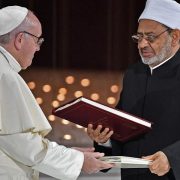
It was an emotional event at UNESCO’s Paris headquarters on the occasion of the Holocaust Remembrance Day event on January 26. The violinist Robert Davidovici played Spanish composer Jorge Grundman’s heart-breaking Shoah for Solo Violin, inspired, as the composer said, by Jewish children’s drawings at a Prague exhibition − the only reminders of their existence. He decided to write this piece to serve as a further remembrance.
One of the speakers was Mrs. Isabelle Choko, the 95-year-old president of an organization representing the deportees to Auschwitz. She was 15 when she was sent to the camp, and she has been dedicating her time since to events that convey personal stories of the Holocaust − when “educated” European societies went amok.
These two parts of the event stood in sharp contrast to the UNESCO speakers relying on platitudes about fighting antisemitism by − hold your breath − “education.” There is no point rehashing well-known pre-WWII great educational statistics of Germany, the Netherlands, Austria, or Hungary. Education has never been an obstacle to antisemitism − not then, not centuries before, and not now.
It was Archbishop Agobard in the ninth-century Frankish-Carolingian realm who relentlessly attacked the power and influence of the Jewish community after Louis the Pious, son of Charlemagne, gave Jews unprecedented freedoms. It was Agobard and the priests below him − not the illiterate hoi polloi − who called Jews “children of the devil.” Agobard repeatedly noted that “things have reached a stage where ignorant Christians claim that the Jews preach better than our priests, some Christians even celebrate the Shabbat with the Jews… Men of the people, peasants, allow themselves to be plunged into such a sea of errors that they regard the Jews as the only people of God.”
There were popes who tried to educate Christendom out of antisemitism but were unsuccessful. Pope Innocent III wrote in 1199 that “They [some Christians] are persecuting Jews on the basis of myths and in sharp contrast to our instructions, against all justice, without process of law, they are taking all their goods, starving them, torturing them.” In 1272, in a papal bull, Gregory X wrote, “It happens sometimes that Christians lose their children and then the enemies of Jews blame them for stealing and killing these children since they need their heart and blood for their sacrifices. Other times the Christian enemies of the Jews hide their children and ask for money from the Jews under the entirely false pretext that Jews stole and killed them.”
In 1236, Frederick II of Germany appointed a public committee to investigate charges of ritual murder of infants. The committee did not find any evidence. Yet the better-educated nineteenth and twentieth centuries still saw such accusations come before the courts in Hungary in 1882 (in Tisza-Eszlar) and in Kiev in 1911 (the Beilis case). And blood libel allusions are used to this day in anti-Israel propaganda.
Even if such flagrant antisemitic accusations are not a daily occurrence, Archbishop Agobard’s millennia-old ones about Jews being rich and powerful and exercising too much influence are constantly made.
Since the Jewish world population is 16 million (about half living in Israel) in a world of 8 billion people, it is not particularly surprising that antisemites must hold onto the belief that Jewish influence is the result of some outrageous conspiracy.
Educated explanations for the Jews’ prominence abound but fall on deaf ears: They were the first widely literate people, anchored by a book no matter where they found themselves; they were forced into “usury,” which later became banking and finance, while others were prohibited to engage in it; they were forcibly moved around the world, creating an eventually valuable global network; laws and regulations excluded them from established industries and thus forced them into emerging ones, entertainment among them; the list could go on.
But these explanations have done little to change the minds of those who want to target Jews. Neither have the Holocaust statistics, films, and personal testimonies − justifying President Eisenhower’s foresight that these documents could still be subject to “cynical doubt.” Indeed, repeated surveys of younger generations both in Europe and the US show astonishing ignorance (genuine or not), and the term “holocaust” has been casually used for events that bear no comparison (such as Stalin starving Ukrainians, or Ottomans killing Armenians), or simply used as a synonym to “genocide.” This is why the Yad Vashem Museum in Israel insists on using the term “Shoah” when referring to the WWII events.
Indeed, in a recent article, Melanie Phillips observed that the UK Commemoration for Holocaust Memorial Day last month “referred to ‘genocides’ in Rwanda, Bosnia, Cambodia, and Darfur, to ‘the Nazi persecution of gay people,’ and to ‘people being persecuted simply because they were Ordinary People who belonged to a particular group.’ But there was no mention of the genocide of the Jews other than two fleeting references.”
What is to be done? Antisemitic attacks are now rampant on the streets of New York, in too many European cities to list, and on US campuses. It would appear obvious that, as during the 1930s, education is not the solution (though some may argue that what passes now in schools, colleges, and universities is more certification and indoctrination than education).
There will always be people who are prejudiced or suspicious of “strangers,” or “outsiders.” But such attitudes do not have to result in crime, murder, or genocide − if laws and institutions require that such people wear masks of tolerance and enforce civil behavior. Although, as with all veneers of civilization, this is easy to destroy, and hard to rebuild.
The 1930s could give the best example of what not to do if we want to sustain the façade of civilization. Germany, Austria, and Hungary all experienced hyperinflation. Russia experienced it a few years before. When people’s savings, inheritance, and access to credit are all wiped out, when the carpets are pulled out from under their feet, they can no longer maintain age-old customs, traditions, and institutions that disciplined and sustained civilized behavior. And the evaporation of financial markets destroys hopes of rebuilding futures through individual effort.
The lasting solution would be to pursue policies to prevent this disintegration or restore prosperity when it has been lost. For it is prosperity and hope that sustain both political legitimacy and tolerance. Otherwise, societies whose members lose hope, run amok and bet on a variety of ideologies − all having in common rationalizations of increased government power being the solution (associated with various new “isms”). Moss Hart and George Kaufman captured the appeal of ideologies in their 1936 play “You Can’t Take It with You”:
Grandpa: Penny, why don’t you write a play about Ism-Mania?
Penny: Ism-Mania?
Grandpa: Yeah, sure, you know, Communism, Fascism, Voodoo-ism, everybody’s got an -ism these days.
Penny: Oh. I thought it was some kind of itch or something.
Grandpa: Well, it’s just as catching. When things go a little bad nowadays, you go out, get yourself an -ism and you’re in business.
Indeed, the saying that “Necessity is the Mother of Invention” is true for models of society too. And unfortunately, few people realize that it can also be the “stepmother of deception.” It takes time to realize that “isms” often deceive, and it is a grave mistake to subsidize the spread of these new ideologies invented during bad times, presenting them as if they are backed by evidence so as to pass as “social science.”
It is not education that sustains or restores tolerance, but proper political institutions, as the facts of our history make clear. The certification offered by colleges and universities steeped in the latest -isms cannot provide either greater tolerance or the stability of our democratic institutions.
One consequence of the overemphasis on such “education” has been to create many rights and prohibitions − but without balancing such creation with obligations and abilities to enforce them. Writing beautifully worded constitutions has not prevented misery: England never even had one, whereas the Soviet Union had one with promises of rights, freedoms, and even paradise on Earth − and everyone knows that it meant nothing.
Historical evidence is clear that policies that prevent hardships − that protect social mobility and accountability − have been the keys to prosperity and tolerance. In a world that has gone from 1 to 8 billion people in the span of a century, sustaining these institutions is tough. But to avoid the horrors of the past, we must learn the lessons of the past: that stability and prosperity − not ideological “education” − are the keys to peaceful and tolerant societies.
Reuven Brenner formerly held the Repap Chair at McGill University’s (Montréal) Desautels Faculty of Management and serves on the board of IEDM. He is the author of many books and monographs, including History: The Human Gamble, The Force of Finance: Triumph of the Capital Markets (Thomson/Texere, 2002). He has also authored a series of articles on finance and currency issues for American Affairs. Previously published on Law&Liberty, 6th March 2023.





